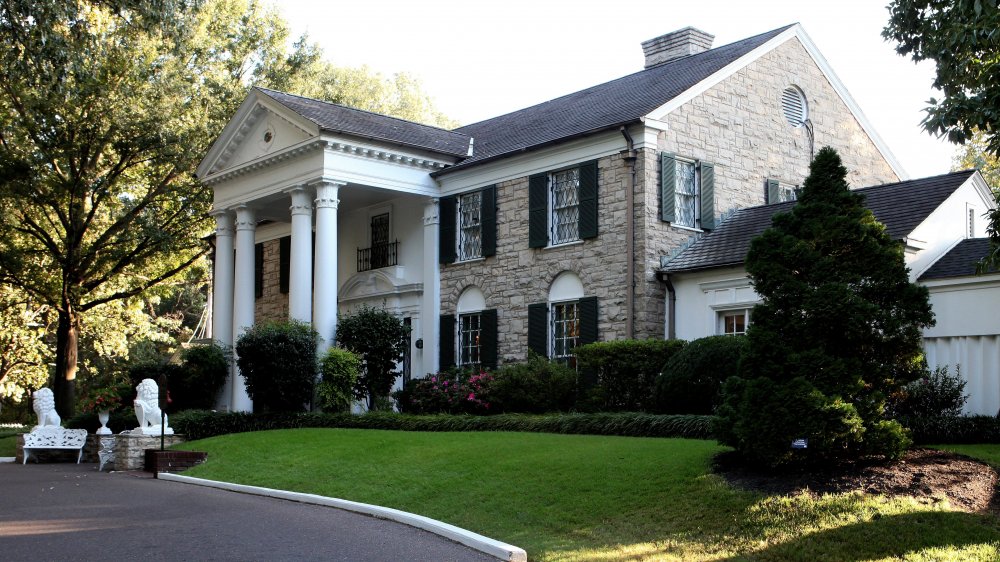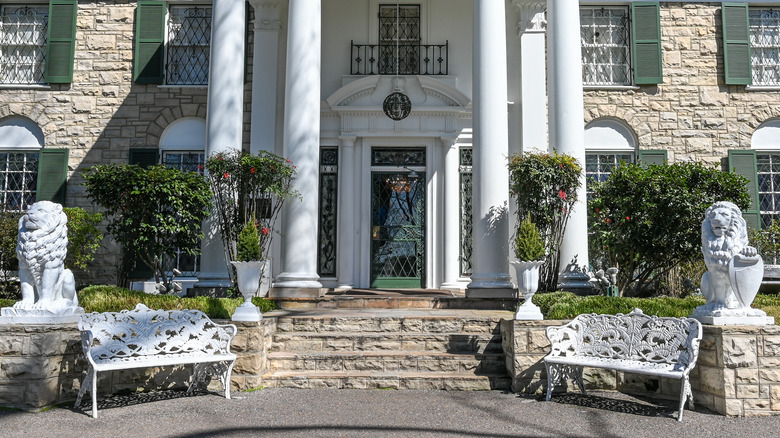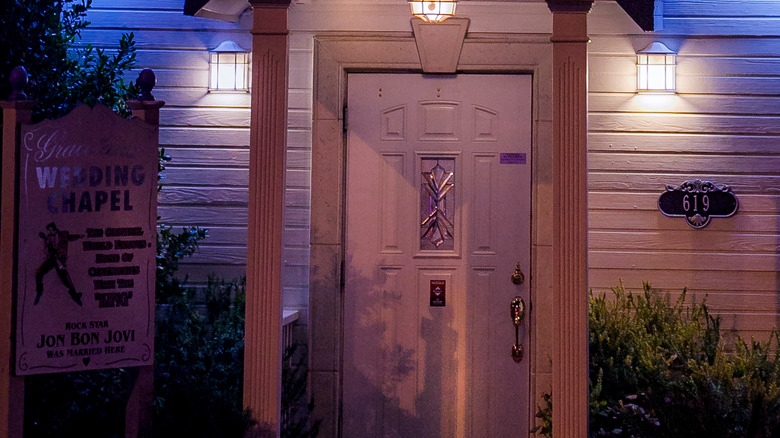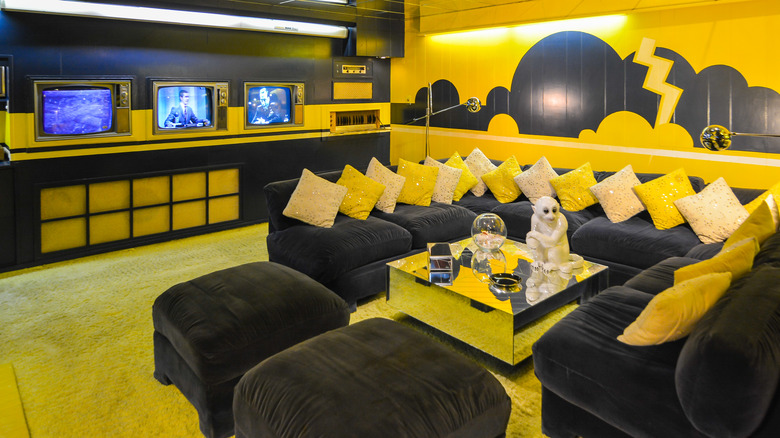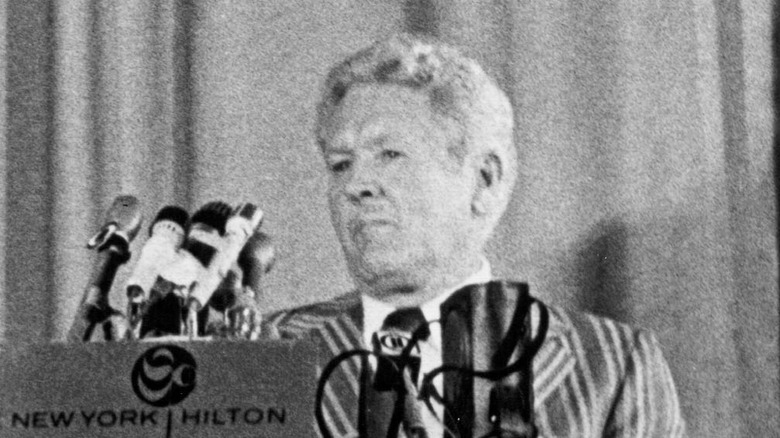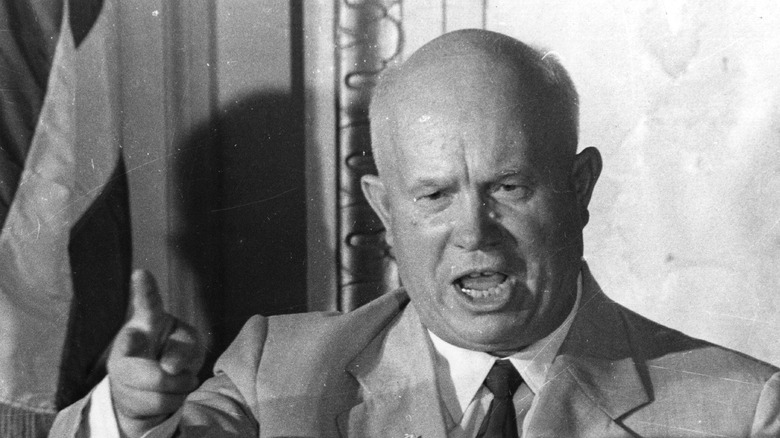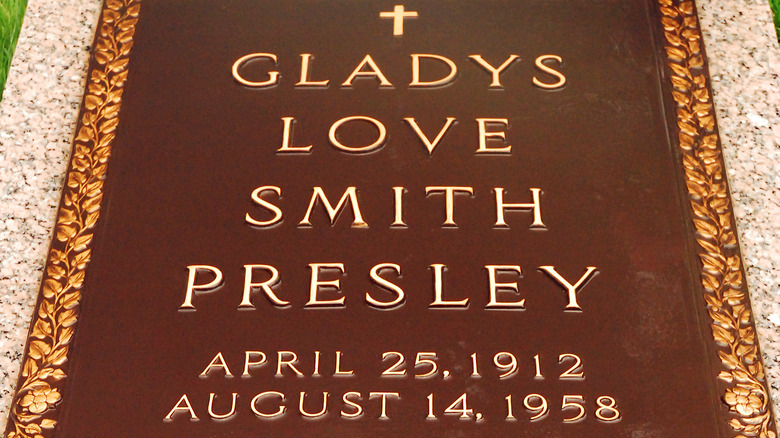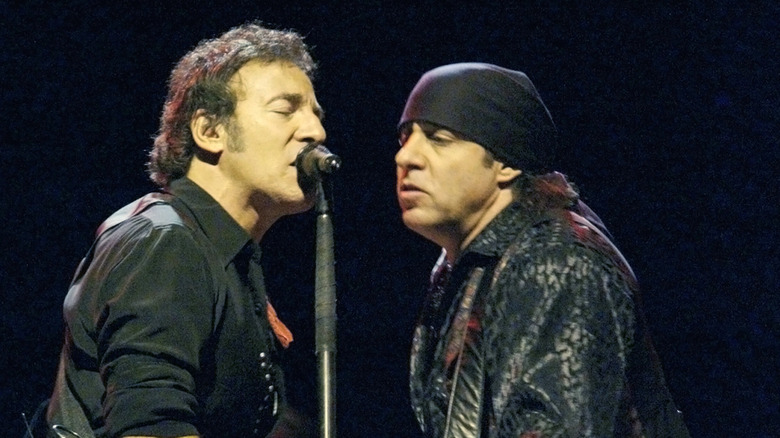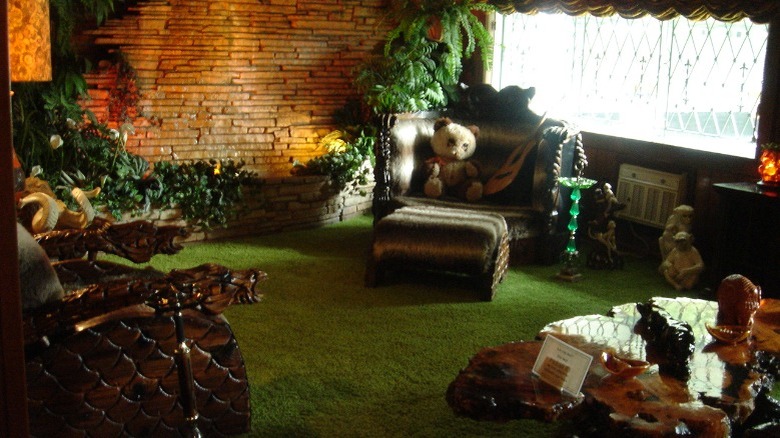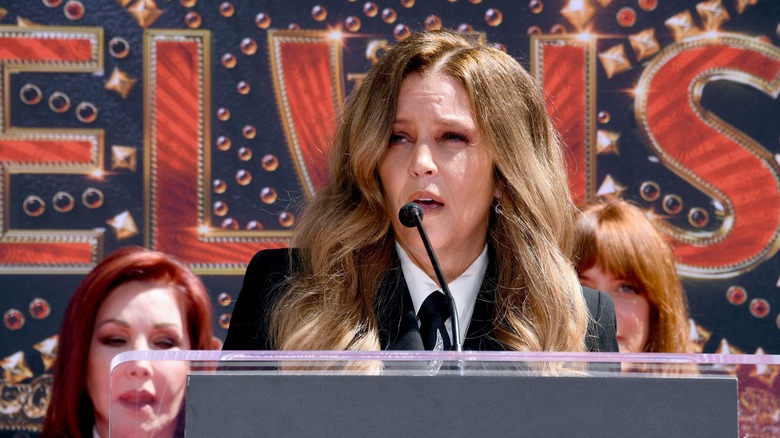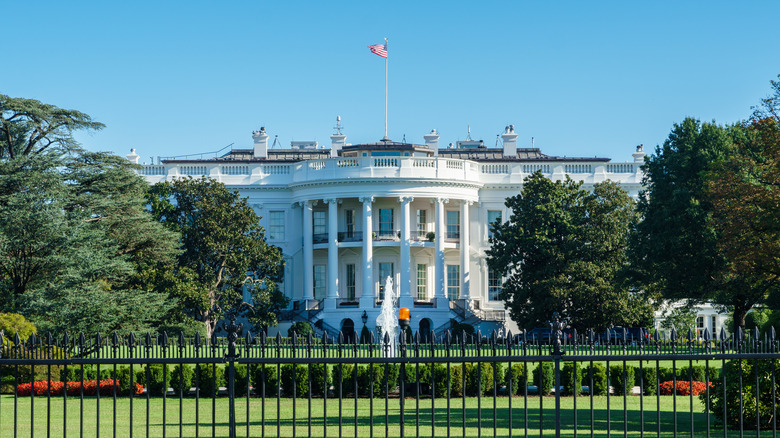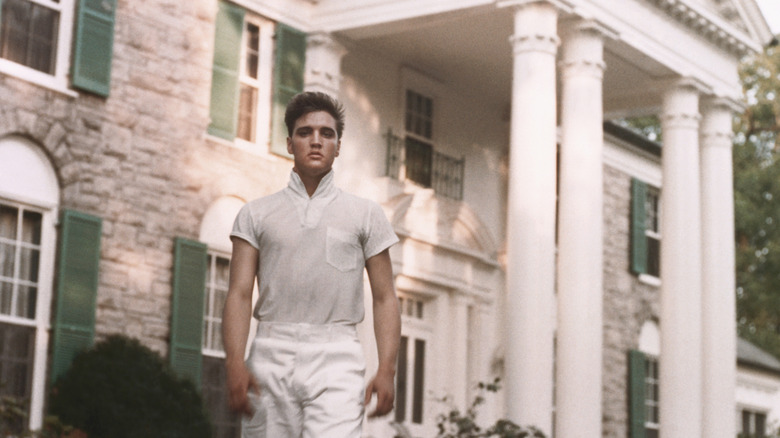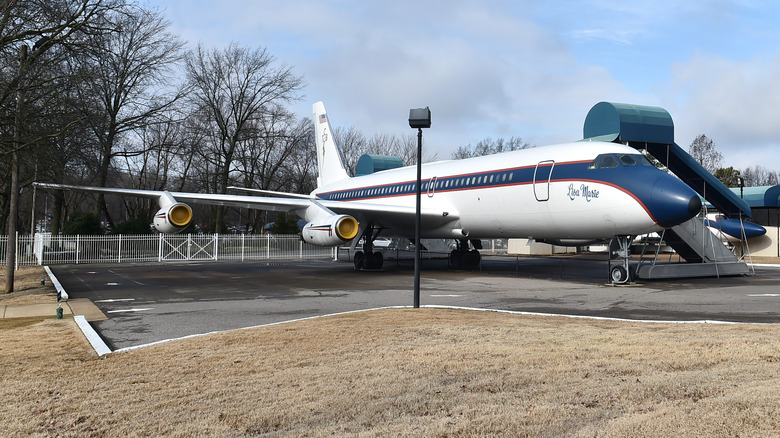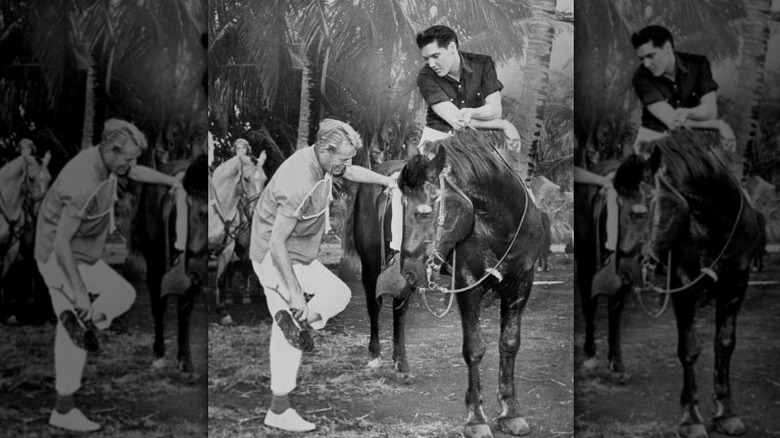Inside Elvis' Graceland And Its Storied Past
Elvis Presley was a lot of things to a lot of different people. The swagger, the hips, the lips, and everything else made him a very different kind of sex symbol for mainstream audiences. He was selling plenty of songs when he started getting booked for national television exposure. "The Ed Sullivan Show" was slow to jump on the bandwagon, and although Elvis's third appearance became famous for censors refusing to photograph his hips in motion while he performed, Sullivan, says History, called him "a real decent, fine boy" — a boy who loved his family.
Elvis was famously good-hearted and generous with his friends, but charity (in the sense of love) begins at home, and a home was one of Elvis's first demonstrations of familial affection. He bought a house for his parents in Memphis, Tennessee, on Audubon Drive, but his skyrocketing popularity meant that the house was becoming a target for fans, polite and otherwise. And the 22-year-old had more and more people to support. He needed room. Rooms, actually. And acres. And a big ol' fence. For privacy.
His parents, Vernon and Gladys, did the shopping while Elvis was in California shooting a movie. He came home to Memphis for a visit in March 1957 and toured the property: 14 acres of woods and farmland, a former cattle ranch, says the Elvis History Blog. Settled on those acres was a house, a Southern colonial, stone, with pillars on the front and room for improvements.
It was named for its original owner's daughter
By the time Vernon and Gladys Presley came upon the 14-acre Memphis property, it already carried the name Graceland. But when Stephen C. Toof, a printing tycoon, first established it in the 19th century, it had no name and considerably more acreage. The National Park Service's registration sheet for Graceland as a historic site puts its initial size down at 500 acres when it was a working farm. Toof named it Graceland for his daughter, according to Karal Ann Marling's "Graceland: Going Home with Elvis." The farm came to its namesake after Toof's death, and when Grace Toof passed on, it was inherited by her niece, Ruth Brown.
Ruth Brown went on to become Ruth Moore when she married Dr. Thomas D. of that name. They decided to build a manor house on Graceland in 1939 and turned to the architectural firm of Furbinger and Ehrman to draw up the plans. It was one of the only domestic homes the firm would build; they typically handled public building projects. They delivered to the Moores a two-story, 10,266 square-foot Neoclassical Revival mansion with five bays, two wings, and 23 rooms (per Home Addict and the official Graceland website). The Moores began living and entertaining in Graceland in 1940, and even brought music into the house early on through their daughter Ruth Marie and her harp (per "Graceland").
It shares a name with two churches
There is a slightly religious ring to the name "Graceland," or so says Karal Ann Marling in "Graceland: Going Home with Elvis." Legend has it that Graceland had been a church before the Presleys came to call it home. That was never the case, but there is a grain of truth to the myth. According to the Athens Banner-Herald, the Graceland Christian Church was originally adjacent to the mansion's grounds. When it was still in Ruth Moore's possession, she donated some of the acreage of her estate to the church, and she allowed it use of her grounds for outdoor functions after she moved out (per the official Graceland website). It helped the Presleys bid for the estate that Elvis agreed to leave the church and its gifted land where they were. (The Graceland Christian Church would later relocate to South Haven, Mississippi, under the name Disciples of Christ.)
There's another religious institution dubbed Graceland, one that owes its name and its very existence to Elvis Presley. It's the Graceland Wedding Chapel in Las Vegas. Presley had no hand in founding or funding the chapel, but his marriage to Priscilla Beaulieu at the Aladdin Hotel inspired it. Perhaps it would be more accurate to call it a pseudo-religious institution. As reported by Marling in "Graceland," all weddings are officiated by justices of the peace, and the "ceremonies" are conducted by Elvis impersonators, all at the flat rate of $250.
Elvis took a strong hand in decorating
One look at Elvis Presley's jumpsuits from his Las Vegas days should confirm that he was a man of idiosyncratic tastes. That was just as true in 1957 when the then 22-year-old purchased the Graceland estate. The mansion was in a mild state of disrepair when he bought it, according to the Phoenix New Times, and Presley's parents eventually hired interior decorator George Golden to renovate it. In recalling the job for the New Times, Golden said that his boss was away filming movies for most of the renovation and that the elder Presleys left him alone to decide Graceland's interiors. The one direction he got from the King was to make Graceland a "showpiece" on par with Red Skelton's house. But according to Karal Ann Marling's "Graceland: Going Home with Elvis," Presley did have some definite ideas about how his home should look, and his mother, Gladys, took care to head some of them off — dark purple walls with white corduroy drapes, for example.
Any visitor to Graceland today won't see much of the initial decorating scheme, as Golden was quick to confirm to the New Times. Presley oversaw several overhauls to Graceland's design in his lifetime as fashions and his own tastes evolved. Among his later additions, per Home Addict, were a custom billiard table in a room with pleated paisley fabric on all the walls and ceiling and his yellow and black three-screen TV room.
The house became a picket line
After purchasing Graceland, Elvis Presley went off to Hollywood. He left the supervision of the renovations to his father, Vernon. When it came time to hire painters to work on the interior, Vernon told Burlington Free Press that he let out the contract, and it was picked up by C. W. Nichols. According to Karal Ann Marling's "Graceland: Going Home with Elvis," Nichols was a friend of Vernon's, but there was no mention of that in the Free Press. And when it came to hiring laborers to do the actual painting? "I didn't give the matter a thought," Vernon told the Press. That was Nichols' task, and he fulfilled it — with non-union painters.
There was no hostility toward organized labor in the Presley family. Vernon had been in the Carpenter's Union, according to the Memphis Press-Scimitar, and Elvis was a member of the Musicians Union and the Screen Actors Guild. Nichols was not a union man but claimed to the Free Press that it had never been an issue when he worked on private residences. But for Graceland, Malcolm Futhey of the Painters Union Local 49 led a picket line, and the bricklayers responsible for laying the Graceland fence honored it. Not so noble were the teenagers who came to the house looking for photographs. "We feel that if Mr. Presley (the father) wants to use non-union workers, that's his business," one of them told the Scimitar.
Khrushchev was denied a visit
It's one of the most light-hearted moments of the Cold War, a story that sounds like something out of a 1950s screwball comedy rather than an actual 1950s event. As reported by History, while visiting the United States for a summit with President Dwight D. Eisenhower, Soviet Premier Nikita Khrushchev arranged an impromptu visit to Hollywood. His tour of Twentieth Century Fox started pleasantly enough. But studio president Spyros P. Skouras thought it a good time to challenge Khrushchev on his infamous "we will bury you" remark, which sparked the premier's temper. The spark blew into a fury when Khrushchev was told that, due to inadequate security controls, he wouldn't get to go to Disneyland.
Nor would he get to go to Graceland, though his reaction to that denial isn't documented. In fact, the source for the claim that Khrushchev was ever bound for the Memphis mansion was Elvis Presley himself. According to Peter Guralnick's "Careless Love: The Unmaking of Elvis Presley," the King invited an Ellis ice show company to Graceland shortly after his discharge from military service. While entertaining his guests, Presley told them that there had been a discussion about taking him by Graceland during Khrushchev's visit to America. The aim would have been to have Khrushchev "see how in America a fellow can start out with nothing and, you know, make good," said Presley. Graceland would have had fewer security risks than Disneyland, but no Soviet representatives ever did pay a visit.
Elvis banished his stepmother from Graceland
Elvis Presley was very close to his mother Gladys. He was her only surviving child, and her only family for the three years Vernon Presley spent behind bars (per the New Zealand Herald). Gladys doted on her son, and Elvis vowed at a young age to take care of his parents. Graceland was, in part, an effort to make Gladys happy. But the trappings of fame — and the loss of her son's attention to his career — hastened the decline of her health, and she died of hepatitis in 1958 at just 46 years old. Her early passing left her son bereft. "He didn't seem like Elvis ever again," said his aunt Lillian Fortenberry.
Two years after Gladys's death, Vernon remarried. He brought his new wife, Dee Stanley, to Graceland. According to "Elvis and Gladys," the star struggled to accept his father's new relationship from the outset. Elvis and Dee never became close. But a breaking point came when, after returning home from filming "G. I. Blues," Elvis found that his stepmother had become the mistress of Graceland and had presumed to redecorate — replacing many a decision Gladys approved of. Elvis was so upset that he tore curtains and threw furniture. He entered into an argument with his father that ended with Vernon and Dee being moved out of Graceland. Though it's worth noting that Dee denied being evicted (per "Graceland: Going Home with Elvis") and claimed she never felt at home in Graceland.
Bruce Springsteen once hopped the fence
Did the Boss ever meet the King? A young Bruce Springsteen once hoped it would be so. He'd already picked up his moniker (which he claims to detest, per the BBC) by 1975, the year he and his fledgling E Street Band found themselves in Memphis, Tennessee. Relating the story for "The Graham Norton Show" years later, Springsteen said that he and Steve Van Zandt set out looking for an all-night diner at 3 a.m. Their taxi driver told them that they could find such a place near Graceland, which immediately changed their plans for the night. They had the driver take them directly to Graceland, and they found the gates locked but the lights on. Springsteen looked to his bandmate and said, "Steve, I'm going in."
Despite warnings from the taxi driver, Springsteen hopped the fence, raced up the drive, and made it as far as the front door before security emerged from the bushes. Nobody lost their cool; the guard simply asked Springsteen what he wanted, Springsteen asked after Elvis Presley, and the guard told him that the King was in Las Vegas. "Could you tell him — and I generally don't like to do this — that Bruce Springsteen was here?" the Boss asked. "He may not know who that is, but I was just on the cover of Time and Newsweek." The guard assured Springsteen that he would pass on the message and calmly escorted him back to the gate.
Elvis recorded his last two albums in the Jungle Room
It's one of the most infamous pieces of the Graceland legacy: the Jungle Room. Elvis Presley never called it by that name himself. According to Home Addict, it was originally a screened patio connected to the kitchen. Presley had it converted into an enclosed den with an indoor waterfall in the 1960s. After his divorce from Priscilla Presley in 1972, he decided to shake up the decor of Graceland, and this was when his den acquired the tiki-themed furniture, green shag, and fake plants that led a journalist to christen it the Jungle Room in 1982, the year Graceland opened for visitors (per Rolling Stone).
To Presley, it was only the den, at least at first. But in 1976, as part of an effort to tempt the King to record a new album after a long dry spell, RCA agreed to move production into Graceland. The size of the Jungle Room — and its cushy, kitschy shag carpeting — were a fair approximation of ideal studio conditions. It was a tight fit for over a dozen musicians and their instruments, and it didn't allow isolated track recordings, but Presley preferred having the band in with him anyway. His heart didn't seem in the sessions, and he failed to turn up to work in his own house by the end, but "From Elvis Presley Boulevard, Memphis, Tennessee" topped the Billboard Country charts that year, and "Moody Blue" followed in 1977.
Lisa Marie Presley owned Graceland
After Elvis Presley's death in 1977, his estate was left in the hands of his father, Vernon, who in turn appointed executors to succeed him on his own death. According to the official Graceland website, they were the National Bank of Commerce in Memphis, Joseph Hanks (Elvis' accountant), and Priscilla Presley, with the estate held in trust until Elvis' daughter and heir, Lisa Marie Presley, came of age. But that estate was in trouble. While nowhere near destitute, Elvis' free-spending in life left meant that his executors faced cash flow problems in maintaining Graceland. Their solution, starting in 1982, was to open it up to public tours.
The trust managed the operation of Graceland as a tourist attraction until 1993 when Lisa Marie came into her inheritance. She created a new trust, the Elvis Presley Trust, to keep up the good work, and established Elvis Presley Enterprises (EPE) as its business arm. Lisa Marie headed EPE until 2005 when, according to CNN, she sold a controlling interest to CKX (later Core Media). Authentic Brands Group picked up the rights to Elvis' intellectual property and assumed the operation of Graceland.
Through all this wheeling and dealing, Lisa Marie retained control of one key piece of her father's legacy: Graceland itself. While operations have been delegated, Lisa Marie was the sole owner of the mansion, its acreage, and all of Elvis Presley's remaining effects until her death.
It's (allegedly) the second-most visited house in America
Tourist attractions hype their appeal. They're almost obliged to. And some of the claims on promotional material can be hard to swallow. When the president of Elvis Presley Enterprises Ltd (EPE) claimed that Graceland was the second most famous home in America, surpassing Mount Vernon and Thomas Jefferson's house in Monticello in international renown, The Guardian's John Harris was understandably skeptical, all the more so when the boast was made so close to Graceland's designation as a U.S. National Landmark.
Good salesmanship can get people talking, however, and not every boast amounts to so much hot air. Architectural Digest ran with the "second most visited home in America" line when it interviewed Priscilla in 2022 (and gave Presley's frequently derided tastes a kinder assessment). Forbes concurred with Harris too, reporting that the White House is the only residence with more annual visitors. The number Graceland sees per year is 600,000. (The White House, per The National, nets 900,000.)
Did Memphis almost lose Graceland?
When state and commerce butt heads, threats can get tossed around. Prominent businessmen and women may vow to leave their communities in a symbolic gesture, or they may claim that they'll relocate their businesses elsewhere if their terms aren't meant. But moving the base of operations is one thing. Physically relocating a building — a mansion, no less — seems a taller order and a ridiculous one at that. Yet that very prospect seemed to loom over the state of Tennessee in 2019. The Wall Street Journal reported that, in the midst of a dispute with the city of Memphis, Elvis Presley Enterprises was considering offers to move Graceland, piece by piece, to Japan, China, or the Middle East.
Joel Weinshanker, the EPE executive who spoke about the offers, insisted to ABC that he hadn't meant it as a threat and that unnamed politicians had used his words as a "misdirection" in negotiations. EPE and Memphis eventually came to terms, which included tax incentives for expanding Graceland with an arena. The practice of giving a certain class of corporations such negotiated settlements has left American cities in a bind, according to Slate, and whether they need such corporate welfare to bring benefits to the communities they're based in is a contested issue. And in the case of Graceland and Memphis, the situation was complicated by a deal the city struck with the Grizzlies that precluded building an arena for a competing attraction.
You can tour two planes at Graceland
There's more to Graceland for a visiting tourist to see than the house itself. Among other items, the King collected airplanes. To have his own fleet of jets was among Elvis Presley's fantasies, according to the official Graceland blog, and he'd owned five before his death, albeit not all at once. But the most well-known of the bunch is the Lisa Marie, a Convair 880 bought in 1975, named for Presley's daughter, and decorated with the same idiosyncratic flair as Graceland itself. The jet was also known as the Hound Dog I, making Presley's 1960 Lockheed Jetstar Hound Dog II.
After Presley's death, OKC Partnership bought the two named planes (per AP). They were first incorporated into the Graceland tourist attraction in the 1980s, with revenue split between OKC and Elvis Presley Enterprises. For a brief time in 2014, it seemed that the planes would leave Graceland, as the agreement between the site and OKC was ending. Plans to set the two planes up as a museum nearby were made, but by 2015, Elvis Presley Enterprises purchased both jets and announced they would remain as permanent fixtures at Graceland.
Graceland has been home to a number of animals
Elvis Presley loved animals. He'd been around them all his life. Per the official Graceland blog, Presley's parents kept chickens and hogs, and among his pets when his family first moved to Graceland was a turkey. The estate's feathered population grew over the years to include ducks, peacocks, and a mynah bird that mimicked its owner's many excuses for dodging phone calls. As for mammals, Presley was gifted a squirrel monkey by the family that eventually served him as a gate guard; bought a chimpanzee that got out of control; and was sent two wallabies from Australia that eventually settled at the Memphis Zoo.
There were less-exotic pets at Graceland too. The Presley family kept a succession of dogs over the years, and Lisa Marie Presley had a cat. Among Presley's favorite pastimes when at Graceland was riding the grounds on horseback. The Graceland blog marks Christmas 1966 as the start of the Graceland stable. Presley bought two horses, one for his wife and one for her friend, and followed up with a palomino for himself. The barn the horses were kept in was named the House of the Rising Sun. Horses are still kept on the estate, and it's required that at least one of them be a golden palomino.
